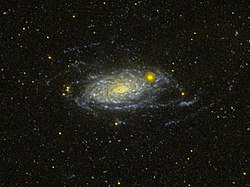Sunflower Galaxy
| Messier 63 | |
|---|---|

M63 from GALEX sky survey
|
|
| Observation data (J2000 epoch) | |
| Constellation | Canes Venatici |
| Right ascension | 13h 15m 49.3s |
| Declination | +42° 01′ 45″ |
| Redshift | 484 km/s |
| Distance | 27 Mly |
| Apparent magnitude (V) | 9.3 |
| Characteristics | |
| Type | SA(rs)bc |
| Apparent size (V) | 12′.6 × 7′.2 |
| Other designations | |
| M63, NGC 5055, UGC 8334, PGC 46153 | |
Messier 63 (also known as M63, NGC 5055, or the Sunflower Galaxy) is a spiral galaxy in the constellation Canes Venatici consisting of a central disc surrounded by many short spiral arm segments. In the Catalogue of Named Galaxies, it is called Helianthus Canum Venaticorum, after the Greek name for sunflower. M63 is part of the M51 Group, a group of galaxies that also includes M51 (the 'Whirlpool Galaxy'). M63 is an active galaxy with a LINER nucleus.
M63 was discovered by Pierre Méchain on June 14, 1779. The galaxy was then listed by Charles Messier as object 63 in the Messier Catalogue.
In the mid-19th century, Lord Rosse identified spiral structures within the galaxy, making this one of the first galaxies in which such structure was identified.
In 1971, a supernova with a magnitude of 11.8 appeared in one of the arms of M63.
Coordinates: ![]() 13h 15m 49.3s, +42° 01′ 45″
13h 15m 49.3s, +42° 01′ 45″
...
Wikipedia
